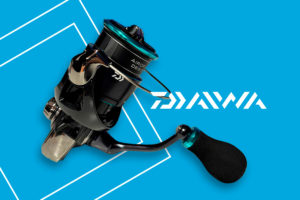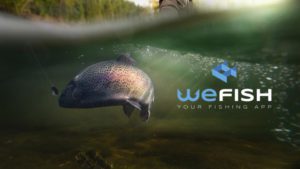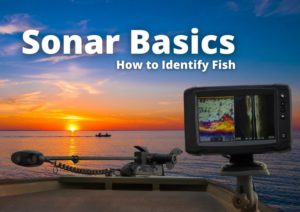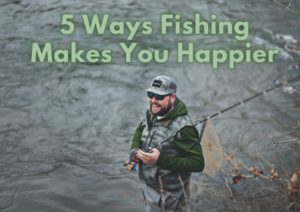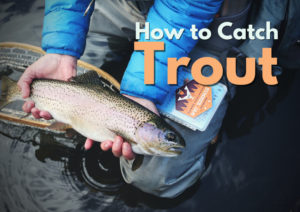Fishing knots may seem like a difficult or boring task, but they are a must for a successful fishing journey, they are one of the most delicate points on equipment. A knot that is too small or too big, with a poor performance or on a wrong line can be one of the weakest points.
For this reason, from WeFish we bring you this summary of the best fishing knots that you can make, useful and simple for those who are starting in this exciting sport.


Fishing line
Fishing lines behave differently with some types of knots or others. That is why it is important to know the different types and choose which one is best suited to the circumstances.
- Monofilament: Monofilaments or hybrid lines join quite well because they generate a lot of friction with each other without causing excess abrasion. In conclusion, they support tying quite well and bear loads very well.
- Braided line: Braided line is one of the strongest diameter-resistance relationships. They have a great handicap, the resistance to the knot is really low. That is why expert anglers recommend using a leader when we fish with this type of thread.
- Fluorocarbon: Fluoro is somewhat more rigid than monofilament but the characteristics of the knots of both lines are very similar. Something that differentiates them is the invisibility of fluro, so it is a good option to use it as a leader in our fishing gear.
Types of fishing knots
At present we can find countless knots for different occasions in the world of fishing. That is because the different types of fishing have led to being necessary each one of them.
- Join different lines: They are used to join lines of the same or different types, eg: monofilament-monofilament, monofilament-braided. Within these, there are specific knots to join lines of different diameter, eg: 0.15 braid with 0.7 fluorocarbon.
- Join mother line with hooks or swivels: created to directly tie our main line with our lure, simple hook, or swivel.
- Specific techniques: For example, in fly fishing, we need to join our line with the leader. Actually this is another knot to join different lines but something different from the previous ones.
The most popular fishing knots
Palomar knot
The Palomar knot is a simple but very safe, resistant and strong knot, which is why it becomes one of the most famous for sportfishing. Its use is very varied but the most common is to join the line or thread to the hook, especially in the cases of braided thread. This fishing knot is used for several modalities such as spinning, surfcasting or carpfishing.
Steps to make a Palomar knot:
- Bend the line and pass the tip through the ring of the hook or lure.
- Make a simple knot with the remaining bow.
- Pull the end of the line down, passing it completely through the hook.
- Pull again on both ends of the line and finish by cutting the end of the line about 3 millimeters from the knot.

Fisherman’s knot
As its name says, the fisherman’s knot is another of the essential fishing knots and it’s also known as an English knot or halibut knot. It is used to join the lines of fishing tackle or to lengthen them, although it should be noted that it is not useful in cases where a very strong knot is needed. There is the possibility of tying more knots and turning it into a double fisherman’s knot to increase its strength.
Perhaps it is one of the simplest to make: It consists of two simple knots, each tied to the central part of the other, as shown in the image below.

Duncan loop knot
Also known as a Uni knot, the Duncan knot is ideal for fly fishing, as it is used to join line and reel, as well as to join two fishing lines or to tie the line to the reel in spinning fishing.
How to tie a Duncan knot?
- Encircle the reel shaft with one end of the line, then join the two lines in parallel and then pass the end of the line backwards, as if forming a loop.
- Make 6 turns through the loop, an action known as “passes”. Attention: It is important to always bring the tip of the line backwards, not forwards.
- Pull gently on the moving part of the line to be able to adjust the turns and close the loop. Finish by cutting off the excess part.

Clinch knot
This basic fishing knot is used to attach the line to the hook or lure and is very resistant. It is also called a half blood knot. The knot has different versions, but whichever one you use it will be very useful on your fishing days. Here’s how to do it:
- Pass the line through the ring of the hook.
- Turn the tip back and give it 5 or 6 turns (it will depend on the thickness of the nylon) on the firm line.
- Pass the end of the line through the loop that is attached to the ring of the hook.
- Moisten the knot, tighten tightly and cut the excess.

Surgeon’s knot
Its name comes from the use that surgeons give to stitch wounds, and it is undoubtedly one of the most popular fishing knots, especially among fly fishing anglers. It is used to join two lines easily and strongly, regardless of whether they are of different sizes or materials. In addition, this knot has variations depending on the turns you give it. Learn how to do it in simple steps:
- Begin by bending the end of the line, making half a knot without actually closing it.
- Give one more turn and make another half knot with the ends.
- Hold the end of the line and part of the knot with your left hand while pulling the loop around through the single knot.
- Hold the loop with the right hand.
- Finish by tightening the knot well (wet it first) by pulling on both ends and cutting the excess thread.
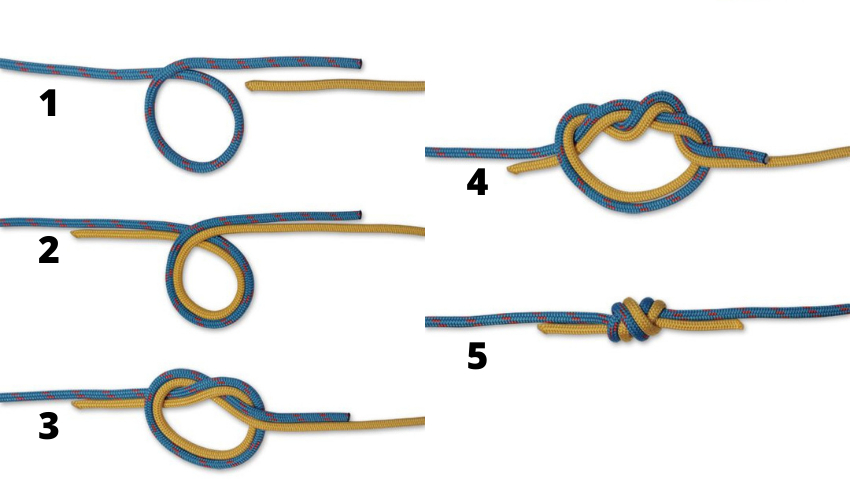
Arbor knot
The Arbor knot is used to tie the fishing line to the spool or shaft of the reel, whether it is spinning, casting, fly fishing or other modalities. It is very simple and effective, it’s a sliding knot to which a stop is made to prevent it from coming loose.
Steps to make the Arbor fishing knot:
- Encircle the spool of the reel with the line and tie a single knot with the end of the line.
- Make a second simple knot at the free end of the line approximately 5 centimeters from the first knot.
- Pull the string towards the reel to slide the first knot until it meets the second one. It is recommended to moisten the line so that they slide better.
- Join both knots and cut the remaining fishing line.
- Tighten the single knots towards the spool.

Blood knot
The blood knot or barrel knot is one of the best knots to join 2 fishing lines of similar diameter. It is very resistant and is quite thin, which makes it very easy to go through the rings. This fishing knot is very popular among Surfcasting anglers, learn how to do it with WeFish:
- Place the lines in parallel.
- Take the end of one of the lines and make some turns (3 or 4) on the other line. Then you have to bend the line back and put it in the gap between both threads.
- Repeat step 2 but with the end of the other line (if you started with the one on the left, now you have to do it with the right one), also passing it through the gap between the two but from the other side.
- Moisten the knot and pull the lines to tighten it. Finish by cutting the excess thread.

Albright knot
This fishing knot is perfect for joining two lines of different thickness, material or diameter, for example a very fine braided line with a monofilament line. The resulting knot is very strong and has a decent thickness to be able to pass through the rings of the rod.
How to tie the Albright knot?
The making of this knot is explained in the following image, attention, it is important to roll the loops carefully around the loop of the largest line.

Rapala knot
We reach to the last fishing knot on this list, the Rapala knot. It consists of a non-slip loop knot that is used to tie the lure to the line, very used in trolling fishing. It stands out for allowing the lure to move naturally through the water, which facilitates the bite of the fish. It is a very strong and useful knot in the case of large species.
Steps to make a Rapala knot:
- Make a simple open knot and pass the end of the line through the hook.
- Pass the line through the knot that was left open.
- Take the short end of the line and roll it 2 or 3 turns on the other line.
- Introduce the short side of the line through the open knot that is made at the beginning, thus forming a new ring.
- Put the end of the line through this second ring that has been formed. Finish by tightening the knot and cutting the excess thread.
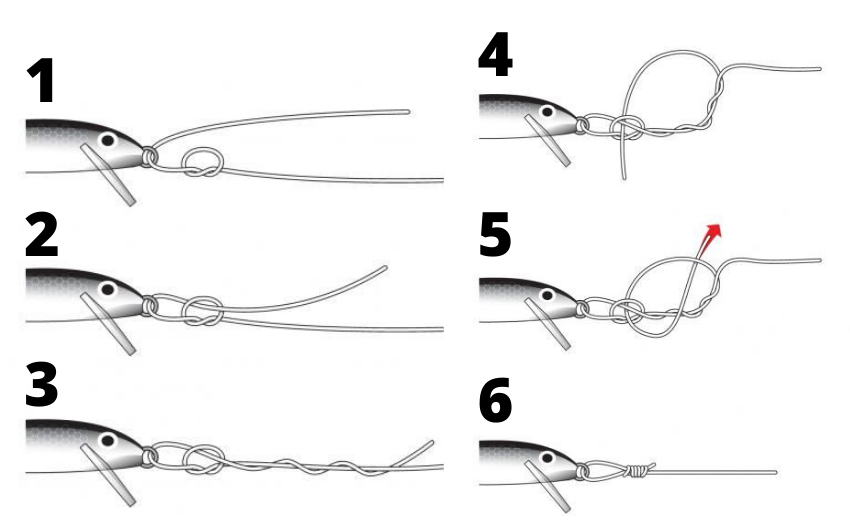
So far the most popular fishing knots, which one do you use the most? Are you missing an essential fishing knot? Let us know in the comments.
If you want to know more about fishing knots, types of fishing knots, tips, and experiences from other fishermen, download WeFish for free. It is the best community of anglers, where you can talk, share photos, videos, and information about any species, modality, or fishing materials. We are waiting for you!



